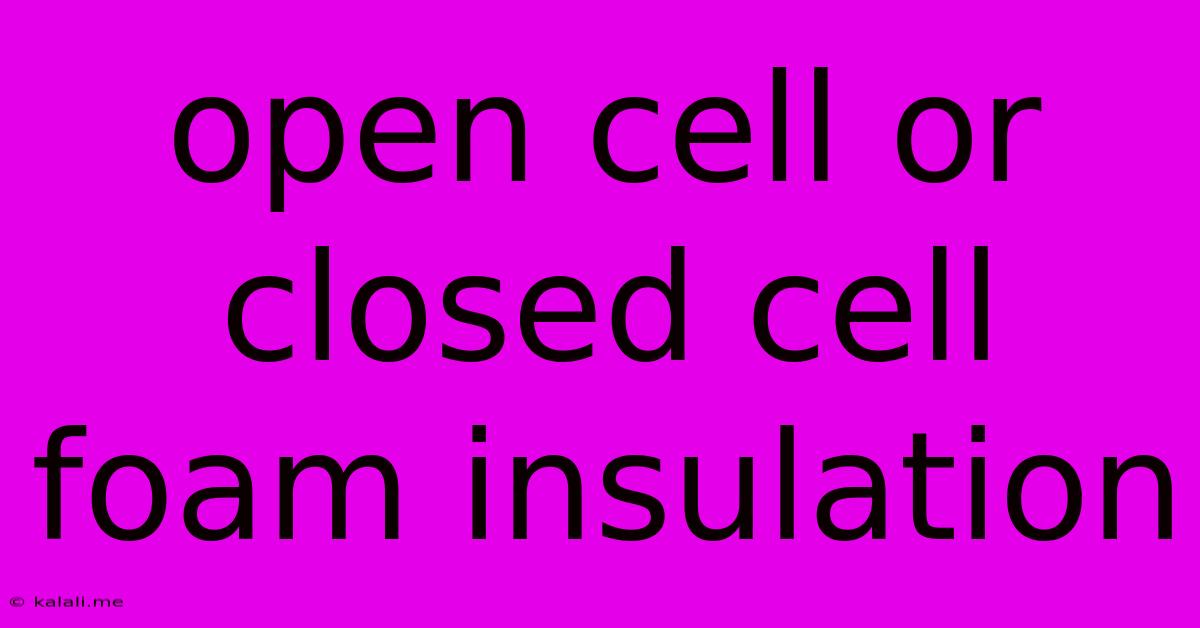Open Cell Or Closed Cell Foam Insulation
Kalali
May 29, 2025 · 3 min read

Table of Contents
Open Cell vs. Closed Cell Foam Insulation: Which is Right for Your Home?
Choosing the right insulation is crucial for maximizing energy efficiency, comfort, and the overall value of your home. Two popular options are open-cell and closed-cell spray foam insulation. Both offer excellent thermal performance, but their properties differ significantly, impacting their suitability for various applications. This article will delve into the key differences between open-cell and closed-cell foam insulation to help you make an informed decision.
Open-cell and closed-cell spray foam insulation are both effective at reducing energy costs and improving indoor comfort by preventing heat transfer. However, their distinct characteristics lead to different applications and performance levels. Understanding these nuances is key to selecting the optimal solution for your specific needs.
Open-Cell Foam Insulation: Lightweight and Breathable
Open-cell foam insulation is characterized by its lightweight nature and relatively high R-value per inch compared to traditional fiberglass insulation. Its open-cell structure allows for some air movement, making it a good choice for vapor permeability and managing moisture.
Pros of Open-Cell Foam:
- High R-value per inch: Offers excellent thermal resistance, helping reduce energy bills.
- Lightweight: Easier to install in some situations, potentially reducing labor costs.
- Air Permeability: Can help regulate moisture and improve indoor air quality.
- Cost-effective: Generally less expensive than closed-cell foam.
- Better sound dampening: Slightly better in reducing sound transmission than closed-cell.
Cons of Open-Cell Foam:
- Lower density: Offers less structural support compared to closed-cell foam.
- More susceptible to moisture damage: Requires careful installation to prevent water infiltration.
- Lower R-value overall: Requires a thicker application to achieve the same R-value as closed-cell foam.
- Less effective air barrier: While permeable, this can lead to less control over air leakage.
Closed-Cell Foam Insulation: Dense, Durable, and Airtight
Closed-cell foam insulation boasts a denser structure with individual cells completely sealed, resulting in superior air sealing and moisture resistance. This makes it ideal for applications where structural support and moisture control are paramount.
Pros of Closed-Cell Foam:
- High R-value: Provides excellent thermal performance with a higher R-value per inch than open-cell.
- Excellent air barrier: Effectively seals air leaks, reducing energy loss and improving indoor air quality.
- High density: Offers significant structural support, increasing the strength of walls and roofs.
- Superior moisture resistance: Less susceptible to water damage and mold growth.
- Longer lifespan: Typically lasts longer due to its superior resistance to moisture and degradation.
Cons of Closed-Cell Foam:
- Higher cost: More expensive than open-cell foam.
- Heavier: Requires more robust support structures.
- Less permeable: May not be ideal in climates with high humidity if not installed properly.
- Can be difficult to install: Requires specialized equipment and experienced installers.
Choosing the Right Foam Insulation: Key Considerations
The best choice between open-cell and closed-cell foam insulation depends on several factors:
- Climate: Closed-cell is preferred in humid or wet climates due to its superior moisture resistance. Open-cell might be suitable for drier climates.
- Budget: Open-cell is generally more affordable.
- Structural needs: Closed-cell offers greater structural support, beneficial for strengthening walls and roofs.
- Air sealing requirements: Closed-cell provides a superior air seal, crucial for maximizing energy efficiency.
- Vapor permeability: Open-cell allows better vapor diffusion, which can be beneficial in certain climates.
Ultimately, consulting with a qualified insulation professional is crucial. They can assess your specific needs, considering your climate, budget, and home's construction to recommend the most appropriate insulation solution, ensuring optimal energy efficiency, comfort, and longevity for your home. Remember to always prioritize a reputable installer with experience in both open-cell and closed-cell foam installation.
Latest Posts
Latest Posts
-
How To Remove Black Mold From Wood
May 30, 2025
-
Fan On Ac Unit Not Spinning
May 30, 2025
-
Dark Souls 3 Pilgrim Not Appearing
May 30, 2025
-
Can You Use Duct Tape Instead Of Electrical Tape
May 30, 2025
-
Why Does Lactose Free Milk Last Longer
May 30, 2025
Related Post
Thank you for visiting our website which covers about Open Cell Or Closed Cell Foam Insulation . We hope the information provided has been useful to you. Feel free to contact us if you have any questions or need further assistance. See you next time and don't miss to bookmark.